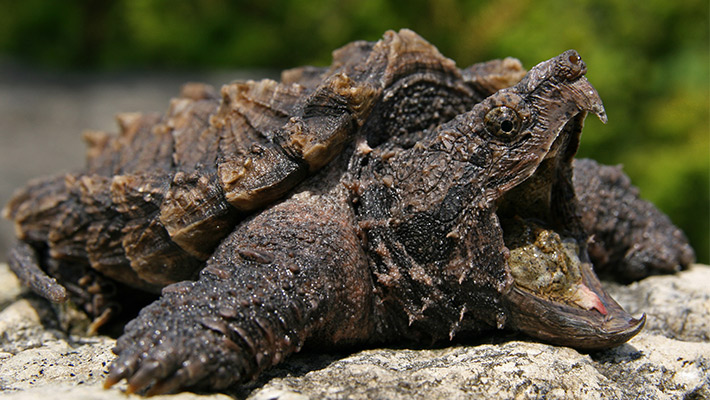Learn about Alligator Snapping Turtle
Scientific name: Macrochelys temminckii
Classification: Vulnerable
Size: Males have shells up to 80cm long and weight up to 90kgs
Distribution: Native to the river systems and swamp of the southeastern United States
Habitat: Freshwater swamps and rivers
Lifespan: 20-70 years
Primary Threats: Illegal wildlife trade for exotic pets, meats, and shells, pollution, pesticides
What do Alligator Snapping Turtles eat?
Alligator Snapping Turtles are carnivorous, eating mainly fish and invertebrates, but will also opportunistically eat birds, mammals, other turtles, and even small alligators. They also sometimes eat vegetation, and act as scavengers eating carrion. The turtles use the red worm-shaped appendage on their tongue to lure fish towards their mouth, before rapidly snapping shut on their prey.
American Apex
Growing up to 90kgs with an 80cm long shell, adult snapping turtles are apex predators of their territory as the top of the food chain. No animal can eat the adults, other than humans. As apex predators, these turtles play an important role in their ecosystems by regulating fish populations, and as scavengers through the removal of animal carcasses.
Eggs and hatchlings are susceptible to predation from birds, mammals, egg-eating ants, and other snapping turtles. American River Otters have been observed preying on juveniles.
Sydney Sewer Monster
These turtles are illegally taken from the wild and smuggled internationally to be sold as exotic pets. Sold as hatchlings, they quickly become too large and aggressive for the home, with buyers sometimes releasing them into local waterways causing harm to wildlife and humans alike.
These turtles have been found in river systems across the United States, and as far away as Europe, Japan, China, and South Africa. In 2000, one was even found living in a sewer in the Sydney suburb Alexandria.
Why are Alligator Snapping Turtles threatened?
This iconic turtle is under threat primarily due to local harvesting for their meat and shells and to be sold as exotic pets. Habitat loss surrounding rivers is also a threat, particularly due to the loss of nesting sites, and degradation of the river quality from pollution and pesticides entering the water.
Saving the Snappers
In the United States, some eggs and hatchlings are now raised in Zoos for release to the wild once mature, protecting them from predators during their most vulnerable period. Alligator Snapping Turtles have also benefited from waterfowl habitat conservation programs that overlap with their territory, and international laws against their trade. You can also help end their trade by refusing exotic meats and pets, and reporting the illegal sale of wildlife to authorities if you see it.
